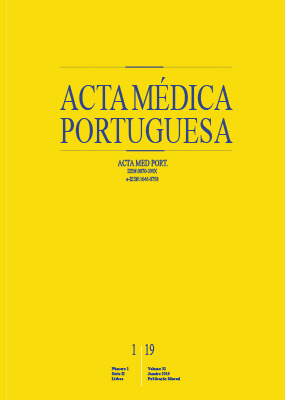Multimorbidity in Portugal: Results from The First National Health Examination Survey
DOI:
https://doi.org/10.20344/amp.11227Keywords:
Chronic Diseases, Health Surveys, Multimorbidity, PortugalAbstract
Introduction: The simultaneous presence of multiple chronic diseases in the same individual is recognized as an important public health problem. Patients with multimorbidity have greater healthcare needs, which represents a higher burden on health services. Although there is no consensual definition of this concept, multimorbidity is usually defined as the presence of two or more chronic diseases in the same patient. The existence of evidence regarding multimorbidity will lead to more efficient management and treatment of these patients.
Material and Methods: In order to estimate the prevalence of multimorbidity and to identify the associated factors, a cross-sectional epidemiological study was developed based on data from the INSEF, a population-based survey conducted on a representative probability sample of the Portuguese population (n = 4911). The prevalence of multimorbidity was estimated for the total population and separately for men and women, stratified by age group, region, education and income. The magnitudes of the associations were measured by the adjusted prevalence ratios calculated by the Poisson regression model.
Results: Prevalence of multimorbidity was 38.3% (95% CI: 35.4% to 41.3%), with higher frequency in women, older people, Lisbon and Tagus Valley; Northern Portugal; Algarve and Alentejo regions and in those with lower academic qualifications. No association was found between multimorbidity and income.
Discussion: Multimorbidity affects more than one third of the Portuguese population. Epidemiological data about multimorbidity in Portugal allows the identification of population groups with higher multimorbidity prevalence.
Conclusion: Our results, which highlight the greater risk of multimorbidity among older and less instructed people, are in line with the literature. These results show the relevance of multimorbidity patients and are especially important in the way how healthcare is organized and provided.
Downloads
Downloads
Published
How to Cite
Issue
Section
License
All the articles published in the AMP are open access and comply with the requirements of funding agencies or academic institutions. The AMP is governed by the terms of the Creative Commons ‘Attribution – Non-Commercial Use - (CC-BY-NC)’ license, regarding the use by third parties.
It is the author’s responsibility to obtain approval for the reproduction of figures, tables, etc. from other publications.
Upon acceptance of an article for publication, the authors will be asked to complete the ICMJE “Copyright Liability and Copyright Sharing Statement “(http://www.actamedicaportuguesa.com/info/AMP-NormasPublicacao.pdf) and the “Declaration of Potential Conflicts of Interest” (http:// www.icmje.org/conflicts-of-interest). An e-mail will be sent to the corresponding author to acknowledge receipt of the manuscript.
After publication, the authors are authorised to make their articles available in repositories of their institutions of origin, as long as they always mention where they were published and according to the Creative Commons license.









